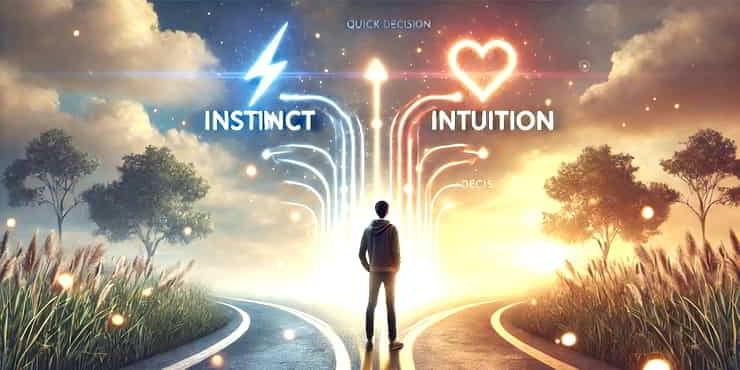Decoding Instinct and Intuition: Navigating the Nuances

Estimated reading time: 5 Min
What is the differences between instinct and intuition? Understanding fine distinctions can help you make more relevant and clearer decisions and actions.
Have you ever felt a sudden urge to act without thinking, or had a gut feeling that turned out to be spot on?
These experiences stem from two fascinating aspects of our human nature: instinct and intuition.
Understanding and taking these into account can help us navigate life’s complexities with more confidence and clarity.
Defining Instinct and Intuition
Instincts and intuition are both powerful forces that influence our behaviour and decision-making.
Instincts are innate, biological impulses that drive our survival.
Intuition, on the other hand, is a subtle, often subconscious, form of inner knowing that helps us make quick and sometimes accurate decisions.
The Biology of Instinct and the Psychology of Intuition
Instincts are hardwired into our DNA.
They are automatic responses to specific stimuli, shaped by millions of years of evolution.
Intuition is more complex, rooted in the subconscious mind.
It involves processing information from past experiences, emotions, and learned knowledge without conscious reasoning.
Understanding the Interplay Between Instinctual and Intuitive Responses
While instinct and intuition might seem similar, they function differently.
Instincts are more about immediate survival, whereas intuition draws on deeper cognitive processes to provide insights that might not be immediately obvious.
Instincts: The Innate Impulses Guiding Our Survival
Instinctual behaviours are automatic and require no conscious thought.
Examples include a baby grasping a finger, or the fight-or-flight response when faced with danger.
Examples of Instincts in Humans and the Animal Kingdom
Animals rely heavily on instincts for survival. Birds migrate, spiders spin webs, and humans instinctively protect their offspring.
These behaviours are vital for the continuation of species.
The Evolutionary Purpose of Instincts in Decision-Making
Instincts have evolved to help organisms quickly respond to their environment.
In humans, these instincts can sometimes override logical thought, guiding us in situations where rapid response is crucial.
Intuition: The Subtle Art of Inner Knowing
Intuition is like an internal compass.
It’s the ability to understand something immediately, without the need for conscious reasoning.
It draws from a wealth of experiences and knowledge stored in the subconscious.
Differentiating Between Conscious Reasoning and Intuitive Thought
Conscious reasoning is deliberate and logical, while intuitive thought is quick and often feels like a ‘hunch’.
Both are valuable in different scenarios, and learning to balance them is key.
Real-Life Examples Where Intuition Plays a Pivotal Role
Intuition is often seen in action with successful entrepreneurs, artists, and leaders.
For example, a business leader might rely on intuition to make a bold move that data alone doesn’t support, or an artist might intuitively know the next stroke to complete a masterpiece.
Distinguishing Between Instinct and Intuition
Many myths surround these concepts. For instance, some believe intuition is purely mystical, or that instincts are always right.
Understanding the science behind them can dispel these myths.
Analysing Situations Where Instinct Overtakes Intuition and Vice Versa
In high-stress situations, instincts might take over due to their immediate nature.
In contrast, intuition often guides us in more complex, less urgent scenarios where we have the luxury of considering deeper insights.
How to Distinguish Between an Instinctual Reaction and an Intuitive Insight
Instinctual reactions are typically quick and based on survival needs.
Intuitive insights might take a bit longer to surface and often feel more like a subtle knowing rather than an urgent push.
The Role of Instinct vs Intuition in Decision-Making
Both instinct and intuition have their place in decision-making.
Balancing them allows for more rounded and informed decisions.
However, both are best listened to at the start of a process and used only as a last resort when making a decision.
In other words, both can be excellent sources of ideas for creativity that can then be developed through logical research and analysis.
Techniques for Honing Intuitive Skills
Practices like mindfulness, meditation, and reflective journaling can enhance intuitive abilities by quieting the mind and allowing deeper insights to emerge.
Awareness is key.
Recognising when an instinctual bias might be at play and taking a moment to reflect can help prevent rash decisions.
The Scientific Research on Instinct and Intuition
Research has shown that specific brain regions are activated during intuitive thinking.
Studies also highlight the effectiveness of intuition in various decision-making scenarios.
Insights from Neuroscience on How Our Brains Process These Phenomena
Neuroscience reveals that while instinctual responses originate in the brainstem, intuitive thoughts involve the brain’s more evolved regions, such as the prefrontal cortex.
While we’ve made strides in understanding these concepts, much about intuition and instinct remains a mystery.
Continued research is essential to unravel these complexities further.
Cultivating Intuition in a World Driven by Instinct
Engage in activities that promote mindfulness, such as yoga and meditation.
Keeping a dream journal and spending time in nature can also boost intuitive awareness.
Balancing Data-Driven Decision-Making with Intuitive Assessment
Incorporate both data and intuition in decision-making processes.
Use data to inform, but don’t discount the valuable insights that intuition can provide.
In my workshops I encourage a culture where instinctual and intuitive insights are considered alongside logical analysis.
This balanced approach can lead to more innovative and effective outcomes.
Embracing Your Inner Guide: Practical Steps for Everyday Life
Start with daily practice of mindfulness meditation to clear your mind.
Reflective journaling at the end of each day can also help you connect with your inner thoughts and feelings.
Consider how Apple’s Steve Jobs often relied on intuition for product development.
Many of his decisions, initiated by intuition, led to ground-breaking innovations.
Ways to Integrate Intuition with Structured Decision-Making Frameworks
Use frameworks like SWOT analysis (Strengths, Weaknesses, Opportunities, Threats) but allow space for intuitive insights during the evaluation process.
Summary
Understanding the differences and interplay between instinct and intuition can significantly enhance your creativity, decision-making and personal growth.
Embrace both these inner guides to navigate life’s complexities with more confidence and clarity.
Ready to cultivate your intuition?
Start today with simple mindfulness practices and reflective journaling.
Enhance your decision-making by integrating intuitive insights with logical analysis for a balanced approach.
If you have anything to add, or questions, please share in the comments, or reach out via the contact form; There’s o such thing as a silly question!
😉
Richard
Useful Resources
- Books:
- Blink: The Power of Thinking Without Thinking by Malcolm Gladwell
- The Gift of Fear by Gavin de Becker
- Intuition: Knowing Beyond Logic by Osho
- Websites:
- Mindful.org – Resources on mindfulness and meditation.
- Psychology Today – Articles on intuition and the subconscious mind.
- Apps:
- Headspace: A popular app for mindfulness and meditation.
- Dream Journal Ultimate: An app to help you track and interpret your dreams.
- Insight Timer: Offers a variety of guided meditations to enhance mindfulness.
- Courses:
- Coursera: Courses on psychology and mindfulness.
- Udemy: Classes on developing intuition and subconscious mind techniques.
- Podcasts:
- The Mindful Kind – Focuses on mindfulness and intuitive living.
- The Psychology Podcast – Explores various psychological topics, including intuition.






